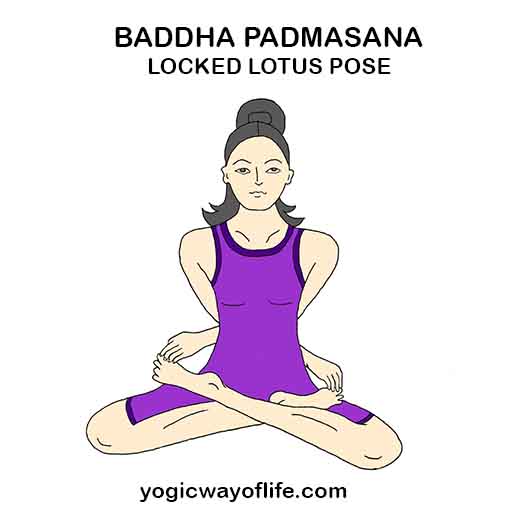Baddha Padmasana or the Locked Lotus Pose is mentioned in Gheranda Samhita. Baddha Padmasana is a meditation pose that gives physical and mental stability. In Hatha Yoga Pradeepika, Padmasana or the classical Lotus pose is considered one of the four main siting poses for meditation. Baddha Padmasana is an enhanced form of the classical Lotus pose where the hands go behind the back and hold the toes of the feet and the head is bent down to form the Chin Lock. The gaze is fixed at the tip of the nose. Those who wish to learn this asana should first master sitting in the simple Lotus pose or Padmasana.
Baddha Padmasana should not be done if you are suffering from sciatica or any form of knee injury or pain. One needs a flexible body, free of flab around the waist to accomplish this asana. Also, women should avoid this asana during pregnancy.

How to do Baddha Padmasana (Locked Lotus Pose)?
- Sit in Padmasana or the Lotus pose. To accomplish this, sit on the floor with legs relaxed. Take the right leg and place it on the left thigh and then take the left leg and place it on top of the right thigh. This is the classical cross legged Lotus pose. One may also place the right leg over the left leg which can be seen in ancient sculptures of yogis and of Buddha in meditation.
- Take the left hand behind the back and hold the toe of the leg on the opposite side. Similarly, take the right hand behind the back and hold the toe of the feet on the left side. This requires a bit if flexibility.
- Bend the head down and place the chin on the chest. This is the chin lock or Jalandhara Bandha.
- Place your gaze on the tip of the nose. This is called Nasikagra Drishti. The eyes can be kept partially closed.
- Maintain this pose for as long as comfortable. Once you master this pose, it can be used for prolonged meditation sessions.
- One of the popular variations of Baddha Padmasana that is practiced today does not use the chin lock and the nose tip gazing. Instead, after step 2, bend the trunk forward and touch the ground with your forehead. Exhale slowly while you bend forward. Do this slowly with full awareness. Remain in this pose for as long as possible. Then inhale slowly and raise the head and straighten the trunk. Take few normal breaths. Repeat the process as many times as you desire.
Benefits of Baddha Padmasana (Locked Lotus Pose)
- Baddha Padmasana helps to achieve physical and mental stability. The mind calms down and practitioner experiences peace.
- This pose creates a certain flow of pranic currents towards the brain that calms down the mind making it fit for introversion and higher practices of meditation.
- Baddha Padmasana gives lot of flexibility of the arms and the legs.
- If the variation (mentioned in step 6) is practiced, it massages the organs in the abdomen and alleviates pain in shoulder and arms.
